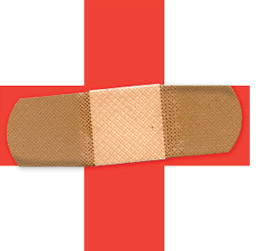academic trend
Help Wanted
Universities and other agencies scramble to fill
the ever-widening nursing gap
by Renée Alfuso / CAS '06 / and Samme Chittum
Everyone has a hospital horror story. “[You] have to go to the bathroom, you buzz for the nurse, and [they] don’t come,” recites nursing professor Christine Kovner. “That’s the standard.” Unfortunately, that standard isn’t likely to improve anytime soon. The demand for nurses—who make up the largest workforce in the U.S. health-care system—now far outpaces their supply. The American Hospital Association reported 118,000 nursing job vacancies nationwide in 2006, and a recent report in the Journal of the American Medical Association says the number could nearly triple by 2020 as the baby boomers gray and require increasing care.
 The issue is more complicated than most imagine. While rising salaries and job opportunities are actually attracting an unprecedented number of would-be nurses, admission bottlenecks and faculty shortages at universities, along with a staggeringly high attrition rate among nurses on the floor, are emptying hospitals of their most indispensable resource. The crisis at nursing schools has gotten so dire that more than 42,000 qualified applicants were turned away last year, according to the American Association of Colleges of Nursing (AACN). "We don't have the faculty or the clinical sites to quickly increase the number of nurses we're graduating," explains Cheryl A. Peterson, a veteran nurse and senior policy analyst for the American Nurses Association (ANA). In fact, the AACN found almost three-fourths of programs suffer from a dearth of teachers, and this shortage is likely to grow because about half of all nursing faculty in the United States are baby boomers themselves and plan to retire within 10 years.
The issue is more complicated than most imagine. While rising salaries and job opportunities are actually attracting an unprecedented number of would-be nurses, admission bottlenecks and faculty shortages at universities, along with a staggeringly high attrition rate among nurses on the floor, are emptying hospitals of their most indispensable resource. The crisis at nursing schools has gotten so dire that more than 42,000 qualified applicants were turned away last year, according to the American Association of Colleges of Nursing (AACN). "We don't have the faculty or the clinical sites to quickly increase the number of nurses we're graduating," explains Cheryl A. Peterson, a veteran nurse and senior policy analyst for the American Nurses Association (ANA). In fact, the AACN found almost three-fourths of programs suffer from a dearth of teachers, and this shortage is likely to grow because about half of all nursing faculty in the United States are baby boomers themselves and plan to retire within 10 years.
In response, schools are exploring a range of creative measures to recruit both students and educators. The Johns Hopkins University School of Nursing offers nurse administrators and advanced practice nurses discounts on tuition, while the University of Chicago Medical Center offers 100 percent tuition reimbursement for nurse employees who want to earn a bachelor's or master's degree and 75 percent reimbursement for those who pursue a doctorate in nursing or a related field. NYU, which has one of the oldest nursing PhD programs, has stepped up its efforts by elevating what was once the nursing division to its own school in 2005. Since then the new College of Nursing, under its first dean, Terry Fulmer, has doubled faculty and nearly tripled student enrollment from 400 to 1,150. In addition, staff nurses at NYU Medical Center can now qualify for tuition reimbursement if they pursue a graduate or doctoral nursing degree.
But luring more students and faculty only fixes part of the problem; there will never be enough nurses until hospitals figure out how to retain those already on staff. Some 41.5 percent of registered nurses in their first year and half on the job seriously consider changing careers, according to a national study—the first of its kind—of 3,226 registered nurses in 35 states and the District of Columbia. "We simply didn't know a lot about these nurses and why they leave," says Kovner, who co-authored the article published last fall in the American Journal of Nursing with Carol Brewer of the School of Nursing at the University at Buffalo. Much of the nurses' frustration, they discovered, is the result of poor management and stressful working conditions: 25 percent found it "difficult or impossible" to do their job at least once a week because of inadequate supplies, 62 percent experienced verbal abuse by either patients or doctors, and 25 percent were accidentally stuck by at least one needle in their first 18 months.
To reduce this turnover, Kovner's husband, Anthony R. Kovner, professor of health policy and management, spearheaded a new master of science for nurse leaders at the Robert F. Wagner Graduate School of Public Service. Working with 28 nurse managers from the New York-Presbyterian Healthcare System and NYU Medical Center, the program offers evening classes for those who want to become better managers and improve working conditions for their peers, and expects to double enrollment in fall 2008.
In the meantime, many national nursing organizations, such as the AACN and the ANA, are pressing the government and various foundations for help. Last December, the Robert Wood Johnson Foundation joined the American Association of Retired Persons to create the Center to Champion Nursing in America, which will lobby for state and federal dollars to expand nursing education. ANA's Peterson says that such efforts should help curb the crisis for now but warns that a long-term solution will only come with a shift in priorities: "If we put the same dollars that go into physician education into nursing, we'd be in a much better place."
Illustration © Opto Design
“If we put the same dollars that go into physician education into nursing, we’d be in a much better place.”
—Cheryl A. Peterson, American Nurses Association






